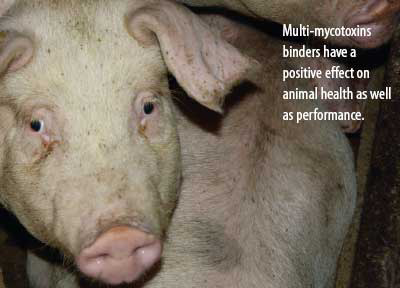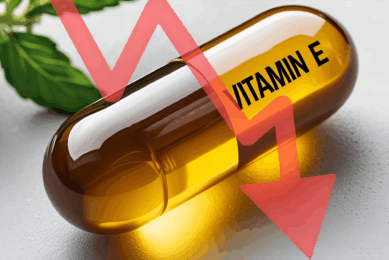Managing mycotoxin problems with versatility

Mycotoxin contaminations in animal feed often involve multiple toxins affecting various aspects of animal health, gut integrity, and animal performance. When developing solutions against mycotoxins, it is important to identify the key target areas and develop specific technologies supported by both in vitro and in vivo research.
By Anna-Katharina Ludger, Nutreco R&D, Boxmeer, the Netherlands
Mycotoxins are still a problem in animal feed production worldwide. In times of raw material scarcity due to adverse weather conditions, such as the drought this year in the United States, raw materials are especially expensive and less available. Producers might be tempted to include lower quality raw materials in their feeds. Mycotoxins that can occur in those lower quality raw materials can vary with climate conditions. Those raw materials tend to be contaminated with at least two or more mycotoxins, since single mycotoxin contamination is relatively rare. Therefore, problems can still be seen, even when mycotoxins occur below the advised limits, because those mycotoxins act in an additive or synergistic manner.
Repeatedly, signs of mycotoxin contamination are not directly recognised as mycotoxin related, like loss in performance and high susceptibility to pathogens with higher severity of diseases. This is mainly caused by the detrimental effects mycotoxins have on the immune system, the gut barrier or the oxidative status of the animals. Effects that can be seen are for example enlarged or shrunken organs as well as inflamed tissues. This shows that the use of low quality raw materials can have a substantial effect on animal performance.
Broad spectrum mycotoxin protection Selko Feed Additives and Nutreco R&D together developed the Toxo concept to preserve animal performance during mycotoxin contamination. The concept works by four different strategies:
- Binding of mycotoxins
- Protection of the gut barrier function
- Modulation of the immune system
- Enhancement of detoxification and reduction of oxidative stress.
1. Binding of mycotoxins – Since the late 70’s it has been known that certain clay minerals can bind aflatoxins. Since then a whole range of in vitro and in vivo trials were done with a variety of compounds and on different mycotoxins. All those trials showed that there are some discrepancies between in vitro and in vivo data and that some mycotoxins, especially those produced by Fusarium species, like for example deoxynivalenol (DON) are difficult if not impossible to bind. Nonetheless, in vitro binding assays, especially the more sophisticated models like the isotherm analysis or the TIM model developed by TNO are a good tool for a first screening when followed up by in vivo studies. A mixture of different smectite clays was found to show the best binding efficacy. These smectite clays do bind mycotoxins in their interlayers by a process called chemisorption. Therefore they have excellent binding efficacy especially for aflatoxins and ergot alkaloids as well as Fumonisins or Ochratoxin A (OTA).
2. Protection of the gut barrier function – The intestinal epithelium has many critical functions. One is the absorption of nutrients, but at the same time it also forms the first protective barrier between the lumen of the gut and the bloodstream of the animal. In this way it prevents translocation of pathogens like bacteria or viruses as well as less absorbable mycotoxins. This intestinal barrier is mainly formed by tight junctions. Several studies showed that mycotoxins such as DON or OTA reduce the protective function of the gut wall by removing specific tight junction proteins like claudin-7 and occludin. Practical implications can range from diarrhoea, inflammation and fever to reduced feed efficiency. By teaming up with the University of Utrecht (the Netherlands), a series of studies were conducted to learn more about possible intervention methods addressing the negative effects of mycotoxins on the intestinal barrier, especially DON and OTA. It was found that even low levels of DON and OTA up to the EU maximum allowed levels, led to loss in barrier function. Certain components called glucose biopolymers however, were found to protect the intestinal barrier of pigs in vivo when exposed to EU maximum allowed levels of DON and OTA. Ingestion of DON and OTA for four weeks led to increased expression of claudin-7 and occludin in the duodenum of piglets. The enhanced gene expression was an indication of a repair mechanism, because these proteins are removed from the complexes and therefore, have to be produced again. Feeding those pigs with glucose biopolymers reduced the gene expression levels to the levels of the control animals, positively affecting the gut barrier function against mycotoxins.
3. Modulation of the immune system – When mycotoxins are absorbed into the blood stream, they influence the immune system. The consequences are very diverse and can range from suppression of lymphocyte proliferation, reduced phagocytic activity of macrophages to reduced vaccination efficacy or disturbed humoral immunity. These effects can lead to higher mortality rates, increased susceptibility of pathogens and higher severity of diseases or to enhanced colonisation of potentially harmful bacteria in the gut. Activated ß-glucans were selected, because they have been shown to activate macrophages, improve lymphocyte proliferation, reduce pathogen attachment and improve vaccination response.
4. Enhancement of detoxification and reduction of oxidative stress – The animal has to detoxify mycotoxins, which is called xenobiotic metabolisation. This process is divided into three phases and every individual mycotoxin follows a different route through this system and thus requires specific detoxification enzymes. During this detoxification process, free radicals are produced that are leading to increased levels of oxidative stress resulting in DNA damage, lipid peroxidation and inflammation or cell death. Practical implications can be reduced overall health status, increased incidence and severity of inflammations or skin disorders. Specific vitamins and antioxidants are included, which up-regulate enzymes in all three phases of the detoxification process as well as reduce oxidative stress.
In vivo validation
The Toxo concept was studied in several animal trials in Europe, North America and Asia. In a recent finished trial conducted at the Sichuan Agricultural University in China for example it was found that Toxo-XL reduces the negative Aflatoxin effects in ducklings. Performance was enhanced especially in the starter period up to day 21 in the high contamination group as shown in Figure 1. Furthermore, during the same period, relative organ weights of spleen and bursa were restored and relative organ weights of liver as well as kidneys were improved (Figure 2).
Another trial with multiple mycotoxin contamination (Deoxynivalenol, Zearalenone and Ochratoxin A) below the legal EU allowed limits was conducted at the Swine Research Centre of Nutreco R&D. The multiple mycotoxin challenge did not have any effect on swine performance, but kidney weight was restored and the incidence of diarrhoea was reduced as shown in Figure 3.
From these trials it can be concluded that, due to the fact that mycotoxin contaminations in animal feed often involve multiple toxins, key target areas have to be identified before developing a strategy which is supported by both in vitro and in vivo research.
[Source: Mycotoxin Special]











